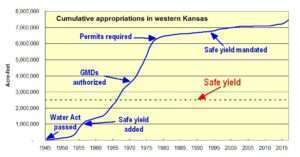By Duane Schrag
Special to the Rural Messenger
(Last in a series)
“Many individuals are probably unaware of their interest in water, but let water become difficult or impossible to obtain … and there is immediate lively concern.”
– Ground-water Resources of Kansas, June 1940
Kansans can’t say they weren’t warned.
More than 80 years ago, long before the Kansas Water Appropriation Act, and center pivot irrigation was still a decade away, it was noticed that water wells in some parts of the state were lowering the water table. This made some people uneasy.
Bulletin 27 of the State Geological Survey of Kansas estimated in 1940 that groundwater reserves held 100 times more water than surface lakes and reservoirs. It marveled that some wells could produce 2,000 gallons per minute.
“Observations of this sort indicate the greatness of a natural resource,” the bulletin went on, “but it is obviously important that supplies of water should not be drawn from such reservoirs at a rate larger than that of their replenishment. Otherwise, the time is bound to come when the resource is no longer available for use.”
This view may have been shared by the Kansas legislature when it passed a law allowing for groundwater management districts. The purpose was for “the proper management of the groundwater resources of the state; for the conservation of groundwater resources; and for the prevention of economic deterioration.”
But the importance of safe yield – that withdrawals from an aquifer should not exceed recharge – was not universally accepted. It was not even mentioned in the 1945 Water Act, which created the framework for Kansas water law.
“Had the Kansas Legislature in 1945 not only adopted the appropriation system, but insisted then, expressly in the Act, that safe yield would be maintained, we would not have the groundwater mining today,” wrote John Peck, one of Kansas’ most revered experts on water law, in a 2003 article for the Kansas Journal of Law and Public Policy.
The omission helped fuel a massive expansion of Kansas’ agricultural economy, but also created the predicted conflicts.
The latest example is a lawsuit filed in January by Audubon of Kansas in U.S. District Court in Kansas City, Kan. It accuses the U.S. Fish and Wildlife Service of failing to protect a water right ensuring sufficient water from Rattlesnake Creek for Quivira National Wildlife Refuge. The Kansas Division of Water Resources, also a defendant in the lawsuit, concluded five years ago that upstream groundwater pumping has reduced streamflow to the refuge by 30,000 to 60,000 acre-feet per year (an acre-foot is about one-third of a million gallons).
‘Safe yield’
Kansas’ relationship with safe yield is complicated.
While it wasn’t in the 1945 Act, “safe yield” did debut in a major revision in 1957. Before then, the chief engineer in the Division of Water Resources was to reject any water right application that was not in the public interest. The 1957 amendment explained :
“In ascertaining whether a proposed use will prejudicially and unreasonably affect the public interest, the chief engineer shall take into consideration the area, safe yield and recharge rate …” among other factors.
In reality, getting a water permit was voluntary.
“Basically, from statehood on to 1978, water development occurred in the state of Kansas without any significant regulation,” says Lee Rolfs, who became the first counsel to the chief engineer in 1978 and served for 30 years.
Until then, a water right was only to provide protection when there wasn’t enough water to go around. State law said users with junior rights (or no right at all) could not impair the rights of seniors – users with an earlier right.
If a user applied for a right and the chief engineer concluded that safe yield had already been exceeded, the user had two choices – go without water, or drill a well and pump, so long as someone with a water right didn’t complain that they could no longer get enough water.
Besides, safe yield calculations require a considerable amount of data, particularly the location of wells.
“When I started in 1978 we had no computers,” Rolfs recalls. “Information was stored on index cards. The permit said you could drill a well or wells in the NE quarter of Section 4. So we knew there were some wells in the NE quarter but we didn’t know [exactly] where they were.”
Nor were there authoritative data on recharge or the volume of groundwater at that time, he said.
By the time “safe yield” was added to state law in 1957, the 135-acre center pivot had been patented for several years. Irrigated farming was about to take off.
A decade later the Legislature was prepared to put the brakes on. Initial legislation in 1968 authorizing Groundwater Management Districts (GMDs) fizzled. A revised version was adopted in 1972.
“As early as the early ‘70s and probably earlier there was a perception of a problem,” says David Barfield, who was Kansas’ chief engineer when the Quivira dispute reached a boiling point. He retired in February 2020. “There was a perception that the chief engineer wasn’t doing anything to deal with it. Really, GMDs were supposed to get the situation under control.
“And they did, to their credit,” he said.
Or tried to.
‘A crisis on the horizon”
By the time the GMD Act was passed in 1972, total appropriations of groundwater west of Hutchinson had reach 4 million acre-feet, more than 1.5 times the total recharge of the area from there to the Colorado line.
And that was only by users with water rights. Untold others were pumping unknown quantities without permits. Water levels in wells seemed to be falling rapidly. The report from the Governor’s Task Force on Water Resources in 1978 confirmed some residents’ fears.
“Kansas, indeed, has major water problems, and a crisis is on the horizon,” the opening sentence reads. “The declining underground water supply of the western third of Kansas threatens the agricultural economy of the entire state.”
That year, almost 40 years after the Water Appropriation Act was passed, the Legislature made it a crime to use water without a right. But by then appropriations had passed 6 million acre-feet, more than twice total recharge.
“I came to work in August 1978, so all this big transition period was occurring,” Rolfs recalls. “[The Division of Water Resources] was flooded with applications because compliance with the Kansas Water Appropriation Act had just become mandatory.”
GMDs quickly closed the door on new wells in many areas. Some, such as District No. 5, made safe yield a fundamental principle in the management plans it adopted (“balance long-term withdrawals with annual recharge,” 1978; “mining our groundwater resource can only lead to deterioration of the economic base,” 1988; “this economy can only be maintained if the water resource is sustained,” 2019).
On the other hand in southwest Kansas, the policy in District No. 3 is to mine water. It allows withdrawals of all the recharge, plus an amount that will reduce the capacity of the aquifer by 40 percent in 25 years.
With large areas of the state closed to new development, appropriations climbed more slowly after 1980. But it wasn’t until 1994 that it became mandatory to preserve safe yield. By then, the state had given permission to pump 6.7 million acre-feet yearly from an area with 2.5 million acre feet of recharge.
It’s now 7.5 million.
“We’ve made some incremental progress,” Barfield says. “There’s been some limited slowing down of [water] use but we really haven’t addressed the problem in a meaningful way.”





